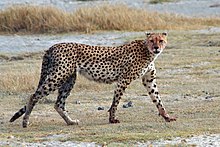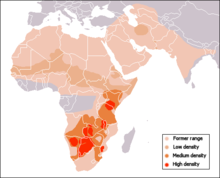Cheetah
![]()
The title of this article is ambiguous. For other meanings, see Cheetah (disambiguation).
The cheetah [ˈgeːpart/geˈpart] (Acinonyx jubatus) is a predator mainly distributed in Africa, belonging to the cat family. Highly specialized in their hunting behavior, cheetahs are the fastest land animals in the world. This is why the cheetah has traditionally been given a special position in the family. However, genetic studies have shown that this is not justified in terms of evolutionary history; the cheetah's closest relatives are American cats (pumas).
The word cheetah derives via the French guépard from the Italian gattopardo, composed of gatto for 'cat' and pardo for 'panther'. The generic name Acinonyx in turn consists of the Greek words ἀκίνητος akínetos, German 'immobile' and ὄνυξ ónyx, German 'claw'.
Features
The cheetah fur has a golden-yellow base colour, whereby the belly side is usually clearly lighter. It is dotted with black spots, which are much smaller than those of a leopard and do not form rosettes. The face is darker and unspotted, but bears two black stripes running from the eyes to the corners of the mouth (lachrymal stripes).
In regard to spotting, the cheetah resembles the leopard, but in shape it differs considerably from it, as well as from all other cats. Cheetahs have extremely long, thin legs and a very slender body, which closely resembles that of a greyhound. The head is small and round, the tail long. The paws bear thick, scaly soles; the claws are only partially retractable (hence the generic name). Because of its physique, the cheetah is the fastest land animal in the world. It can reach up to 93 km/h in a run, but can only sustain this high speed for about one to two seconds. The cheetah's average top sprinting speed is 53.11 km/h, much less than the highest recorded to date; this is explained by maintaining as much maneuverability as possible. The cheetah's anatomy is also designed for speed in other respects: its nasal passages are considerably widened, leaving little room for the dentition, which is greatly reduced in size compared to other cats, making it a relatively weak weapon. The lungs, bronchi and adrenals are also proportionally greatly enlarged.
A cheetah reaches a head-torso length of 150 cm, plus 70 cm tail. The shoulder height is 80 cm. Despite this stately size, he only brings it to a weight of 60 kg.
According to recent studies, there are only two subspecies or even only two populations, namely the African and the Asian cheetah. At the same time, a strikingly low genetic variability with inbreeding rates almost equal to those of laboratory mice was observed; consequently, it was suspected that the cheetahs might also be susceptible to diseases and environmental changes. However, it is not yet clear whether this genetic uniformity is a significant disadvantage for the animals in the wild.
It is considered largely certain that it is possible to transfer tissue between cheetahs without a rejection reaction - something that was otherwise only thought possible in the case of genetic identity (→ identical twins). Genetic and immunological studies have established that today's cheetahs of South and East Africa are probably all descended from a very small ancestral group (→ genetic bottleneck) that lived about 10,000 years ago. At that time, the American cheetah became extinct, and the common cheetah apparently only narrowly escaped this fate. It subsequently spread again in the savannahs of Africa and Asia (→ purging) and was therefore able to survive until our own time. This study is highly regarded among experts and is now used as a classic example in population genetics.

Cheetah in Ngorongoro Crater, Tanzania
.ogv.jpg)
Play media file High speed video of cheetahs racing

Cheetahs
_(cropped).jpg)
Broadened nose and dentition of the cheetah
Range and habitat
The cheetah was once widespread over almost all of Africa, with the exception of the Central African forest areas; furthermore, the Near East, the Indian peninsula and parts of Central Asia were populated. Today it is found almost exclusively in sub-Saharan Africa. In Asia, there are tiny remnant populations that are threatened with extinction (see subspecies). The last cheetah was sighted in India in 1967/1968, and the species has since been considered extinct there. A reintroduction attempt of eight African animals is planned for November 2021 in Kuno National Park in Madhya Pradesh.
Cheetahs are pure savannah and steppe animals. They prefer areas with tall grass providing cover and hills as display points. Too many trees and bushes make a landscape unsuitable for cheetahs, as they cannot use their speed there. In semi-deserts, on the other hand, cheetahs do well if they can find enough prey.

Range of the cheetah: Extinct Low stock densities Average stock densities High stocking densities
Questions and Answers
Q: What is a cheetah?
A: A cheetah is a medium to large sized cat that lives in Africa and Asia.
Q: Is the cheetah the fastest land animal?
A: Yes, the cheetah is the fastest land animal.
Q: How fast can a cheetah run?
A: A cheetah can run up to 112 kilometers per hour for a short time.
Q: Where do most cheetahs live?
A: Most cheetahs live in the savannas of Africa.
Q: When are cheetahs active and when do they hunt?
A: Cheetahs are active during the day, and hunt in the early morning or late evening.
Q: Are there any cheetahs in Asia?
A: Yes, there are a few cheetahs in Asia.
Q: What is the scientific name for a cheetah?
A: The scientific name for a cheetah is Acinonyx jubatus.
Search within the encyclopedia